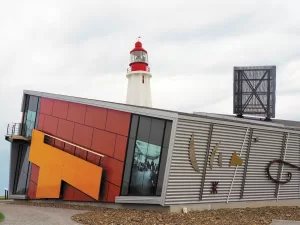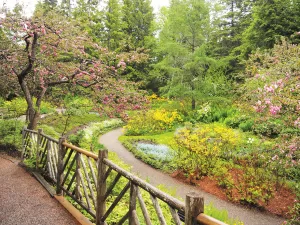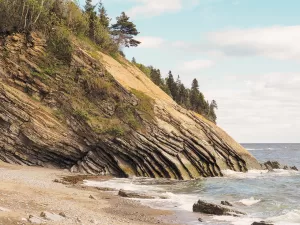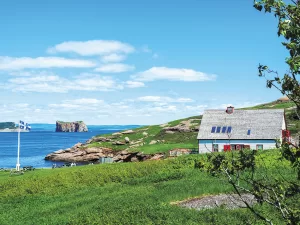Located in Canada’s Gaspésie–Îles-de-la-Madeleine, this coastal paradise offers many fun and educational opportunities.
By Josephine Matyas, F468364
August 2023
Somewhere between a French coat of arms carved into a tall wooden cross and the preserved fossil of a 350-million-year-old fish, I realized Québec’s Gaspé region is not like anywhere else on earth. This peninsula at the eastern reaches of Canada’s “La Belle Province” is a patchwork of forested hills, sinuous roads hugging a rugged coastline, small villages, and the power of the sea.
At the farthest point, it’s the massive Percé Rock rising from the waters of the Gulf of St. Lawrence that’s captured in hundreds of thousands of photos and on postcards. That rock — the one with the hole in it — may be the instantly identifiable emblem of the Gaspé (Gaspésie in French), but following the coastline route to that iconic spot is a captivating journey on its own. In 2013, National Geographic Traveler added Gaspé to its list of “Canada’s 50 Places of a Lifetime.”
Along the way one encounters a sampler of “best in the Gaspésie”: seafood so fresh you can clock its haul from the saltwater in hours; lighthouses; a submarine; shipwrecks; world-class parklands; aquariums; and museums that show how the sea leaves its mark on the past, present, and future.
The peninsula’s circle route — roughly 600 miles — works well when traversed in either direction. Gaspé boasts many campgrounds, both private and public, but reservations are necessary in the summer and fall seasons. A handful of Québec’s provincial parks (operated by Sépaq, a government agency that manages the province’s parks and reserves) allow dogs in campgrounds.

Pointe-au-Père Maritime Historic Site includes the Empress of Ireland Museum and Pointe-au-Père Lighthouse.
ROUTE DE LA MER
Our journey began in Rimouski along the shoreline-hugging Route 132, also known as Route de la Mer, or “sea road.” Just east of the city is the excellent Pointe-au-Père Maritime Historic Site, where a cluster of buildings — including a historic lighthouse, an early-20th-century submarine, and a museum dedicated to the Empress of Ireland tragedy — are testament to the challenges of navigating the majestic St. Lawrence River.
By the early 1900s, thousands of ships sailed the St. Lawrence, moving immigrants and tons of cargo across the Atlantic. But the river’s infamous temperamental weather, sudden fog, shoals, and tides tested many a sea captain. Not far offshore, on a foggy night in 1914, over 1,000 souls were lost when the Empress of Ireland ocean liner was hit starboard, sinking in just 14 minutes. A poignant museum dedicated to the tragedy, Musée Empress of Ireland is filled with multimedia displays that tell the story of the sinking, and pieces retrieved from the depths include the ship’s wheel, compass, and propeller. A self-guided headphone tour is available in both English and French.
Towering beside the museum is the Pointe-au-Père Lighthouse, a Parks Canada National Historic Site. At 108 feet, it is one of the tallest light stations in the country. Visitors may climb the 128 steps to the top for an unusual perspective of the St. Lawrence River.
Nearby sits the HMCS Onondaga, the first Canadian submarine to open to the public. The vessel was home to a crew of 70 “submariners,” nicknamed the “silent service” because they were often on classified missions. Visitors can explore the interior via a self-guided audio tour. Another option is a virtual tour made possible by an interactive game on a programmed tablet that guides you through the sonar screens, periscopes, depth indicators, engine room, and torpedo launch control.

Thousands of plant species thrive in Reford Gardens.
It’s a lot to take in, but the perfect place for some quiet reflection afterward lies just a half-hour east at the sublime Reford Gardens (Jardins de Métis), where six full-time gardeners tend to 3,500 varieties of plants, including the signature Himalayan blue poppies. The 100-acre property is home to the International Garden Festival, North America’s largest contemporary garden festival, held from the end of June to the beginning of October, when blooms are at peak flowering power.
Amateur gardener Elsie Reford planned, planted, and coaxed a staggering variety of foliage and flowers over three decades in the early 1900s. Her passion and dedication set the groundwork for gardens that are the work of a lifetime, along with winding paths, benches for quiet contemplation, and small wooden bridges over bubbling streams.

Exploramer showcases the marine environment of the St. Lawrence River.
The St. Lawrence River’s expanse of water is lined by rocky shorelines and pockets of tidal pools. It’s home to whales, seals, fish, and other creatures, among them shrimp, sea stars, sea cucumbers, and jellyfish. Beneath the waves, a hilly underwater terrain creates a wide range of temperature and light conditions. Just think of it as an enormous water-stirring machine, where the seawater shapes everything — a story told at Exploramer, an excellent aquarium and museum dedicated to this saltwater environment.
The aquarium’s touch pools, large tanks teeming with almost 60 different species of sea life, and multimedia exhibits explain the who-what-where. A virtual bird-watching station serves as a window into the behavior of Gaspé’s four main species of seabirds. Tours and signage are in English and French.
Close by, one of our favorite campground discoveries was the small but well-tended Parc et Mer Mount-Louis. The space overlooks the waters of the gulf, catching the wind and the sunrise, with 56 campsites (most have hookups), including some pull-through sites.
ROLLING HILLS TO THE LAND’S END
Winding, dramatic, and hilly are words to describe “La Haute-Gaspésie,” the far reach of the peninsula, which is peppered with lighthouses, brightly colored cottages, and small museums dedicated to the story of the region. The many docks, boats bobbing in the water, and shops tell of the fishing heritage — salmon, lobster, and shrimp are all pulled from the waters. There are steep hills along Route 132 but also frequent passing lanes and pull-off spots.

The Appalachian Mountains dip sharply into the sea at Forillon National Park.
Just before the entrance to Forillon National Park, the Cap-des-Rosiers Lighthouse, Canada’s tallest at 112 feet, signals the powerful and erratic currents offshore. Built in the mid-1800s, the stone tower’s light was first fueled by whale oil, then petrol, and now electricity. The beacon still uses the original 1854 polished glass lens imported from France.
Next door, Forillon National Park’s Visitor Information and Discovery Centre is filled with state-of-the-art activities, and a film showcases the biodiversity of the park. Visitors also can enjoy a view from the water by embarking on a coastal maritime cruise offered by outfitter Griffon Aventure.
Forillon, managed by Parks Canada, is a forested nature park protecting ancient fossils, wildlife, seabirds, and the area’s indigenous heritage. It’s a nature-lover’s paradise, and a spot to rest, recharge, and appreciate the Gaspésie’s uniqueness. The parkland covers a deep indentation in the terrain. The north shore juts into the Gulf of St. Lawrence, and the southern shoreline faces the moderate waters of Gaspé Bay. Two campgrounds in the park accommodate RVs — Petit-Gaspé in the south area and Des-Rosiers in the north — with some sites that have electrical hookups and a smaller number that offer electricity and water. Centralized dumping stations are available.

Overlooks in Forillon National Park offer sweeping panoramas.
The park is home to wildlife such as black bears and moose, several scenic drives and hiking trails, and historic spots the likes of Hyman & Sons General Store, built in 1864 and reconstructed to the golden era of cod fishing. A popular picnic spot is the outlook at Cap-Bon-Ami, a seabird sanctuary where the road ends and the ancient cliffs drop into the gulf, marking the Appalachians’ northeasternmost tip in North America.
Leaving Forillon is always hard, but good things wait ahead. In the town of Gaspé, the excellent Musée de la Gaspésie offers an interactive education about local maritime history. Standing sentinel outside, dramatic cast-iron sculptures represent explorer Jacques Cartier’s first contact with the Iroquois. Cartier sought refuge during a storm in 1534 and erected a cross to claim the land on behalf of the king of France, signaling the beginning of New France. Soon after, it was the rich cod fishing that brought settlers to the Gaspé from France, Ireland, and the Channel Islands. This created a mix of communities that bear names in English and French.
It’s a short drive to Percé, the small community with the famous pierced block of rock rising offshore. The village has become a cultural and culinary hub and a popular tourist destination known for lobster fishing, day trips to Bonaventure Island (a Québec park that protects biodiversity, including a massive colony of northern gannets), and boat tours. When the fishing industry went into decline after World War II, fishermen added benches to their boats and — voilà! — tourism was born.

Not far from Bonaventure Island, Percé Rock rises from the waters of the Gulf of St. Lawrence.
Near Percé, Route 132 swings to the southwest and hugs Chaleur Bay. The landscape becomes gentler, with more farmland. The national historic site at Banc de Pêche de Paspébiac protects a dozen historic buildings resurrected to the 1860s, a prolific time when each of 1,400 barges would catch over 600 cod daily. The cod fishing empire — fishing, salting, and packing — once made this stretch of coastline the largest cod trading business in the world.
There is no better way to end the spectacular Gaspésie circle tour than at Miguasha National Park, a Québec park and UNESCO World Heritage Site that’s a window to the Age of Fishes — roughly 400 million years ago — with plant and animal fossils that shed light on the origins of the first earthly vertebrates. The park’s bayside cliffs contain some of the oldest sediment, from a time when the Appalachians formed, creating the perfect conditions for one of the world’s most famous fossil beds. The park has a hiking trail with interpretive signage, as well as an excellent museum.
Some might look at a map and view the Gaspé as “way out there.” But perhaps it’s just a simple matter of taking an extra step and being rewarded tenfold.
FURTHER INFO
Le Québec Maritime
www.quebecmaritime.ca/en
Tourisme Gaspésie
www.tourisme-gaspesie.com/en
(800) 463-0323

